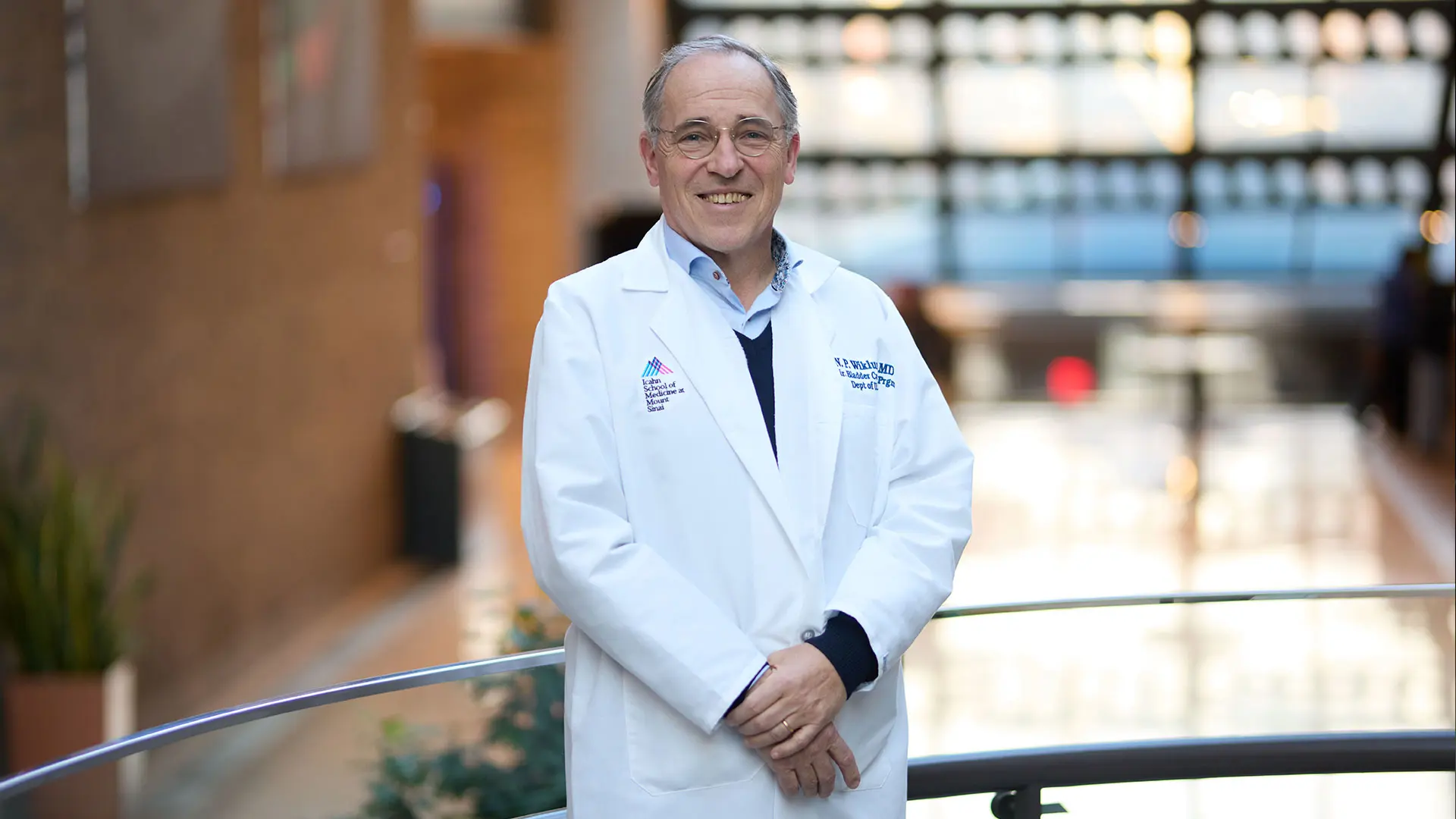
Peter Wiklund, MD, PhD, Professor of Urology in the Department of Urology at the Icahn School of Medicine at Mount Sinai and Director of the Bladder Cancer Program at the Mount Sinai Health System
Despite its complexity and its association with significant morbidity, open retroperitoneal lymph node dissection (RPLND) remains the standard of care for select-stage patients who present with testicular cancer. But Mount Sinai urologists are exploring the potential of using a different approach for this technically challenging surgery: robot-assisted RPLND.
“Of all the surgeries I have done, this area is the one that has the most to gain from a robotic approach,” says Peter Wiklund, MD, PhD, Professor of Urology in the Department of Urology at the Icahn School of Medicine at Mount Sinai and Director of the Bladder Cancer Program at the Mount Sinai Health System. “That’s because you convert from a very large open surgery to a minimal incision, and almost all patients can leave the hospital the next day.”
Dr. Wiklund, a world-renowned surgeon, joined Mount Sinai in 2018, coming from the Karolinska Institutet in Stockholm, Sweden, where he was Chair of Urology, Molecular Medicine, and Surgery, and had developed extensive experience with the procedure. He performed the first robot-assisted RPLND at Mount Sinai and has been working with his colleagues at Mount Sinai as the Department has shifted its approach in this area from performing open surgical procedures to robotic procedures.
According to Dr. Wiklund, the approach in Sweden is different from the United States. In Sweden, doctors are more likely to perform surgery in these cases, while in the United States doctors have tended to first use chemotherapy. Chemotherapy has worked well. But there has been some concern in the United States about the long-term side effects of chemotherapy, as this cancer is most frequently diagnosed in men ages 20 to 34. So there has been more interest recently in the surgical approach rather than chemotherapy, he says, and Mount Sinai is at the forefront.
“Now patients can choose between chemotherapy and surgery, depending on the stage and type of tumor they have,” he says.
John Sfakianos, MD, adopted the robot-assisted approach to RPLND in 2019. A high-volume surgeon with extensive expertise in testicular cancer treatment, he determined that it was a viable alternative to an open RPLND. Instead of making an incision that extends from the xiphoid to the pubic bone, he is able to use a minimally invasive approach with a robot and five small incisions to resect tumors in the retroperitoneum. The process takes approximately two to three hours, and patients are usually discharged the next day.
“We have performed the procedure approximately 20 times and have definitely observed improved outcomes from the standpoint of recovery,” says Dr. Sfakianos, Assistant Professor of Urology at Icahn Mount Sinai. “Length of stay is the most significant area of improvement, and patients are able to return to their normal activity quicker. We also have not observed any increase in complications or worse cancer-related outcomes. For these reasons, while still in its infancy, we think it is a viable alternate approach for the treatment of complex patients, but will need further studies to validate our findings.”
Robot-assisted RPLND is also a viable alternative to laparoscopic RPLND, which was introduced in the early 1990s to address the significant morbidity associated with open RPLNDs but has proven to be equally challenging for surgeons to perform without extensive experience in laparoscopic tumor resections.
Given that surgeons are increasingly being trained in robotic platforms, Kyrollis Attalla, MD, Assistant Professor of Urology, believes robotic RPLND has the potential to become reproducible. Even so, he knows some surgeons remain skeptical as to whether the robotic approach is advantageous to an open RPLND.
Also part of the treatment team in the Department of Urology is Reza Mehrazin, MD, Associate Professor of Urology, along with Matthew Galsky, MD, Che-Kai Tsao, MD, and Bobby Liaw, MD, in the Department of Medicine (Hematology and Medical Oncology), and Richard Stock, MD, in the Department of Radiation Oncology.
“This has been a very contentious topic for many disease sites, but for urologic cancers there has not been any indication that a robotic approach is inferior in any way,” says Dr. Attalla. “What we can say is that we are discharging patients earlier with a very low morbidity profile, significantly less pain, excellent cosmesis, and quicker return to bowel function. Thus, in our experience the robotic approach has many benefits.”
These observations are borne out by a retrospective, multicenter study in which Mount Sinai participated. The study looked at 90 consecutive patients who underwent robotic RPLND for post-chemotherapy treated germ cell tumors with negative tumor markers at seven academic centers in the United States and Australia, respectively.
A review of patient characteristics, perioperative data, and short-term oncological outcomes found that surgery was uneventful in all cases. Seven patients (8 percent) were electively converted to open surgery due to failure to progress and positive frozen section. The median blood loss, operative time, and length of hospital stay were 150 mL, 5.6 hours, and two days, respectively. The 90-day complication rate was 14 percent. Five patients (5.5 percent) had disease recurrence at 12-month follow-up, and one death due to progression of disease was reported.
“This is the largest reported series of robotic RPLND to date, and it shows that this is a suitable alternative to the open approach based on appropriate patient selection at centers that have expertise in testicular cancer and minimally invasive surgery,” Dr. Sfakianos says. “That said, longer follow-up is warranted.”
Seeking further data to assess the efficacy and safety of robotic-assisted RPLND versus the open approach, Dr. Sfakianos and Mount Sinai are currently organizing and leading a first-of-its-kind multicenter prospective clinical trial. The trial is enrolling approximately 250 males ages 18 and older who have been diagnosed with testicular cancer that is seminomatomous (stage 2a or 2b, with up to 3 centimeters of lymphadenopathy) or non-seminomatomous (stages 1a, 1b, 2a, and 2b, with up to 3 centimeters of lymphadenopathy and a post-chemotherapy mass of less than 3 centimeters). Participants must also have normal serum tumor markers, and their performance status must be excellent.
“The primary objective of the clinical trial is to assess progression-free survival at two-years among patients, and that includes local, distant, and serologic survival,” explains Dr. Attalla. “The secondary objectives are any in-template recurrence, any retroperitoneal recurrence, the lymph node yield, recurrence patterns, all complications—especially high-grade complications, which we define as Clavien-Dindo grade three or higher—and ejaculatory function.”
If the data gathered bears out Dr. Sfakianos’ initial observations and the findings of the retrospective study, robot-assisted RPLND could become the new standard of care for patients presenting with testicular cancer. For now, it is a practical option he is able to offer patients, and one of many novel approaches Mount Sinai is exploring to advance treatment.
“It is one more way in which we are building a comprehensive program for testicular cancer that is innovative, not just in the approaches we offer but also in the research we are conducting,” he says. “We want to continue advancing the field and the modalities for treating patients.”
Featured

Kyrollis Attalla, MD
Assistant Professor of Urology

John Sfakianos, MD
Assistant Professor of Urology